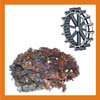From TKWB - Traditional Knowledge World Bank
Jump to navigation
Jump to search
| INNOVATIVE TECHNOLOGIES AND SOLUTIONS |
 |
| Technique: |
DEVICES FOR THE CREATION OF HUMUS |
| Title: |
Modern use of the two-outlet toilet |
|
Description of the innovative solution
Lavatory for the production of compost: the disposal of excrements can be transformed into a resource producing water for irrigation and fertile soil. In urban areas today, multiple devices exist that are capable of directly processing waste, without the need to build sewage systems. These lavatories for the production of compost are systems based on the “aerobic digestion” of waste. The aerobic systems are free of odors and the exhaust fumes emitted are compost of carbon dioxide and water vapor, contrary to the anaerobic process that, beginning without oxygen, creates bad odors and creates methane gas. The production of compost takes place in a decomposition room in which organic soil is created and which must be placed below the discharges of the bathroom and kitchen. It is necessary that the decomposition room be made accessible for inspections and to be able to remove the humus that is produced (between 11 and 38 liters per person per year). The compost obtained has a bacterial content, consistency and color similar to the superficial layer of soil. Similar devices have been created for the transformation of compost from organic kitchen waste. Larger scale systems call for the use of herbal purification, directing water within cultivated terraces that purify the liquid through the physiological process of plants irrigated by it. Devices of herbal purification on terraces are devoid of courses of rivers for disposing of water and where the same treatment for lagooning is a stretch for the environment.
Advantages and sustainability
This technique is sustainable because it reuses wastes otherwise discarded in order to create fertile soils. The process of creating humus from waste is an organic process, more specifically the aerobic digestion of waste. The humus produced can then be purified also using organic processes.
Images

Toilet with autonomous system of compost production.

System for the disposal of used water with terraces and phytoremediation.

(From Top Left- clockwise) Distribution drain, Vegetation, Collection drain, Impermeabile membrane or clay,
Dirt or fine gravel, Radical apparatus, Slope max 1%, Gravel distribution filter
Details of the system of disposal of used water: percolation bed used in the creation of subsuperficial flow systems.

Details of the system of disposal of used water: the perforated pipes disperse the water in the ground.
Deepening
|
TRADITIONAL TECHNIQUE DATA
| Product manufactures: |
|
| Author: |
|
| Other authors: |
|
| Reference: |
|
|
|